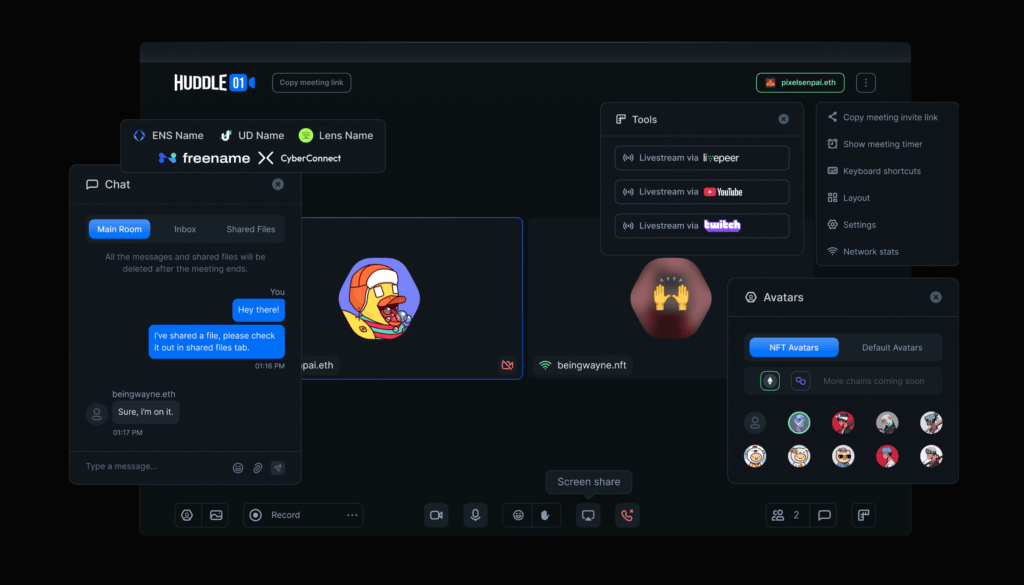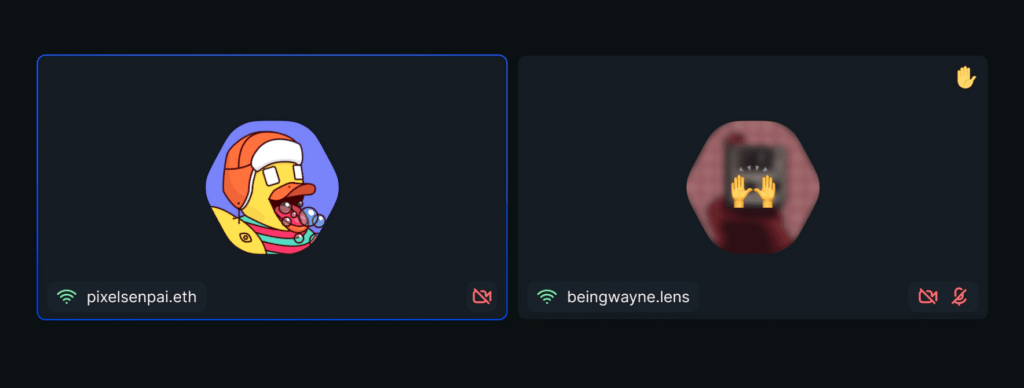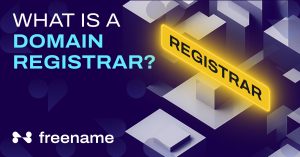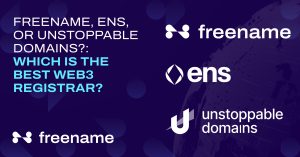How Do Web3 Meetings Work: A Complete Guide
Web meetings are quite common these days. To be precise, 11 million virtual meetings take place every single day, mainly for business purposes.
Most businesses rely on traditional Web2 setups to hold virtual conferences and meetups. However, these platforms lack the necessary support to accommodate all the participants using different browsers.
Moreover, there’s always a risk of data loss as traditional platforms rely on central servers to store your conversations, videos, and text. You can overcome this limitation by opting for Web3 meetings.
Web3 meetings offer an innovative platform powered by blockchain technology. These meetings support peer-to-peer networking, which means that each participant has equal authority over the meeting.
In this post, we will explain how Web3 meetings work, the difference between centralization and decentralization for conducting a high-profile virtual meeting, and why you should be investing in blockchain for a better future.
Understanding Web3 Meetings
Most of you must be familiar with the decentralized web or blockchain web and why it is perceived as the next evolution of the internet. Web3 meetings is one of blockchain web’s crucial applications that doesn’t compromise on delivering a secure, user-centric experience.
The participants can collaborate in a secure environment without having to share their real identities. Moreover, there is no fear of information leaks or getting hacked, thanks to blockchain technology.
The following comparison will further explain the concept of Web3 meetings.
Traditional Online Meetings vs Web3 Meetings
The technology behind the two makes a lot of difference between traditional online meetings and Web3 meetings.
- Typical online meetings require two-step verification to access. In contrast, Web3 meetings provide a unique blockchain-based ID that conceals your original identity from others.
- Web3 meetings are more secure and transparent. That’s possible due to the decentralized network and its open-source protocols.
- You enjoy equal ownership just like any other member in the meeting and can control your data in any way you want. In comparison, traditional virtual meetings implement their own controls.
- One of the major drawbacks of traditional Web meetings is that users don’t have access to non-service-driven tools. Moreover, they can’t integrate apps that may be important for their web meeting. In comparison, Web3 meetings enable participants to leverage a wide variety of dApps and Web3 tools.
- Web3 meetings are cost-effective because there are no intermediaries. Traditional meeting apps charge subscription fees, and other platform-related fees may be involved.
The following table shows why Web3 meetings are better than traditional web meetings:
| Features | Online Meetings | Web3 Meetings |
| Technology | Centralized servers | Blockchain, decentralized |
| ID Verification | Standard two-step or three-step verification; Centralized ID | Blockchain-based ID, high anonymity |
| Security | Standard encryption; risk of central point failure | Cryptographic encryption; smart contracts |
| Authority and ownership | Platform-owned data and content. | User-owned content and data |
| Transparency | Often low | High, because of open-source protocols, public ledgers |
| Control | Controlled by the service provider | Controlled by the user; decentralized governance |
| Interoperability | Depends on platform | Seamless with other dApps and other Web3 services |
| Accessibility | Controlled by platform; account-based | No single point of access; Wallet-based |
| Costs | High cost due to subscription and platform fees | Lower cost because of no intermediaries |
| User experience | User-friendly interfaces, mature experience | More technical as Web3 apps are still emerging |
| Innovation | Depends on provider | Community-driven; rapid |
| Resilience | Moderate (depends on central servers) | High (based on distributed networks) |
Key Features of Web3 Meetings
Understanding the features of a Web3 meeting is crucial due to its extensive potential across many different fields. The core concepts, such as decentralization, blockchain technology, tokenization, and smart contracts, are worth paying attention to if you want to utilize Web3 meetings to their full potential.
Here are some key features of Web3 meetings:
Decentralization
A top-secret government meeting or a high-profile online conference require decentralized environment that ensures data security and uncompromised privacy. This is where decentralization is pivotal.
Decentralized Web3 meetings ensure that users own and control their data and that their authorities are equal. It is a censorship-resistant environment that allows participants to share information without any fear.
Instead of central servers, decentralized communication protocols allow participants to communicate in a peer-to-peer environment. For example:
- InterPlanetary File System (IPFS): A distributed network protocol that enables participants to store and share files, such as meeting minutes or other important documents.
- Secure Scuttlebutt (SSB): SSB is another decentralized communication protocol that supports encrypted conversations. It allows users to communicate instantly during Web3 meetings.
- Decentralized Identifier (DID): Decentralized identity is important in order to get access to a Web3 conference. You can independently create a unique decentralized identity using DID.
A decentralized Identifier is a kind of identity protocol that functions without central authority. DID empowers participants to independently create and manage their digital identities for any company.
These protocols establish a collaborative platform where participants can share information that may otherwise coincide with the censorship policies of Web2 meetings.
Enhanced Security
The basic purpose of Web3 is to shift ownership and control from central servers or entities to a widely distributed network of nodes. The entire network thrives on blockchain technology, which ensures maximum data security.
Blockchain networks mitigate the risk of data losses that are associated with central points of failure. For example,
- Server outages often result in significant data loss.
- Data breaches or thefts occur while central servers are dysfunctional.
Secondly, blockchain technology democratizes the Web3 ecosystem. This means that every participant in the Web3 meeting has equal authority.
Some noteworthy security features enabled by blockchain technology include:
- Cryptography: Every data stored in blockchain has a unique encryption. The block in which the data is stored has a cryptographic hash that connects it to other blocks on chain. Only users with the right decryption key can access the stored information.
- PoW and PoS: Proof of Work (PoW) and Proof of Stake (PoS) are consensus mechanisms that exhibit how committed a particular user is to the network. These mechanisms play a vital role in minimizing scams and maximizing data security.
- Zero-Knowledge Proof: This technique involves a Prover and a Verifier of a particular information. The prover claims that he has the required information while the verifier asks questions to ensure that the claimant is right. There are different types of Zero Knowledge Proofs, such as ZK-SNARKS, ZK-STARKS, and Recursive ZK-SNARKS.
- Immutable Ledger: All transactions are kept in a public ledger, also known as the blockchain ledger. It prevents the users from deleting or manipulating information. Manipulating data in the ledger is difficult since all the subsequent blocks need to be changed.
Data security is a major concern of traditional online meetings, and there is no better way to address it than decentralization. Web3 meetings ensure that:
- Your identity and data will remain hidden, and
- Only you have the authority to share the data you own with the participants of your choice.
Interoperability
Besides enhancing data security and identity protection, Web3’s purpose is to build an ecosystem where all digital apps connect and interact seamlessly to render a cohesive user experience. This interoperability is hard to achieve in Web2 applications because of compatibility issues.
Traditional meeting apps mostly require plugins or add-ons and third-party verification tools to connect with browsers or other web applications. In most cases, users have to utilize applications authorized by the web meeting platform.
However, thanks to advanced protocols like NOTO, Web3 meetings elevate you to another level where interoperability is a must-have.
Web3 users can integrate thousands of dApps without any third-party verification. They can utilize these apps to ensure a smooth flow of data across platforms. For example, there are more than 4,500 dApps only on the Ethereum chain, delivering robust interoperability and innovation.
Smart Contracts

As the name implies, Smart contracts are agreements stored in a blockchain network that operate automatically when predefined conditions are met. They liberate Web3 users to build and execute complicated agreements instead of involving a central authority.
Smart Contracts are condition-based; hence, they are an excellent tool to deploy for Web3 meetings to build trust among participants. Moreover, they can be used in a number of ways to automate certain tasks, for example:
- Defining and enforcing rules and regulations of the meeting,
- Maintaining discipline in the meeting
- Task allocation or performance tracking
- Making sure only authorized participants can access meeting documents
- Ensuring each participant signs off on meeting minutes
Top 5 Advantages of Web3 Meetings

With the above features, we can deduce the following benefits of Web3 meetings:
- Web3 meetings are more secure than traditional online meetings, thanks to the encryption methods associated with blockchain technology.
- Web3 meetings ensure complete privacy as the users can leverage DID protocols to create a unique meeting identity. Moreover, their data remains private.
- Web3 meetings offer greater control and ownership for participants, which is not possible in traditional online meetings. Participants have the authority to share the data they own.
- The integration span in a Web3 meeting is broader than that of traditional web conferences. Participants have access to a wider range of dApps for information sharing, data analysis, funds transfer, task allocation, performance tracking, decision-making, and more.
- Considering their interoperability and flexibility, Web3 meetings offer a massive room for innovation. New meeting formats with improved interaction and flexibility could be created using the latest Web3 apps.
Using Freename as a Web3 Meetings Host
Freename’s potential as a decentralized meetings platform offers a compelling alternative to centralized services like Zoom and Google Meet. By leveraging blockchain technology, Freename ensures secure identity verification and robust participation in online conferences. This is particularly advantageous for distributed groups or organizations that prioritize anonymity, safety, and freedom.
With Freename Domains, you can either set up your own Web3 hosting platform or participate in online Web3 conferences. A decentralized conference hosting platform will surely help distributed groups and communities that value data privacy, anonymity, and freedom.
To learn more about hosting Web3 meetings with your Freename domain, check out this tutorial.
Hosting Web3 gatherings on Freename empowers users with greater control over their data and identities, eliminating the need to rely on third-party providers. Freename has partnered with Huddle to enhance the decentralized hosting experience, allowing users to directly host meetings from their Freename account without requiring a Huddle account. Huddle guarantees secure, end-to-end encrypted meetings, ensuring all discussions are thoroughly protected.
Integrating Freename’s Web3 domain hosting into its platform presents an opportunity for users to experience the benefits of decentralized technology firsthand. With Freename and Huddle, users can trust that their online interactions are secure and private, providing peace of mind in an increasingly digital world.
Real-World Applications of Web3 Meetings
The span of Web3 meetings spread across various industries. Some of the real-world applications include:
- Decentralized Autonomous Organizations (DAOs): These business entities are able to maintain transparent governance through Web3 meetings.
- Healthcare: Web3 meetings are a crucial aspect of healthcare, enabling medical practitioners and doctors to conduct telemedicine sessions in a highly secure environment to ensure maximum patient data privacy.
- Education: Universities and higher education institutes find Web3 meetings safe for conducting online classroom sessions, interviewing sessions, and assessments of foreign candidates. These sessions are powered by blockchain credentials for secure verification.
Organizations that are successfully using Web3 meetings include:
Conclusion
Due to their decentralized nature, web3 meetings have become increasingly popular across various sectors, such as education, healthcare, DAOs, etc. These decentralized meeting platforms ensure enhanced autonomy, security, privacy, anonymity, and interoperability.
Participants can control their data and determine who they can interact with. Moreover, all participants have complete authority over the online meeting, which traditional online meetings can’t promise.
The underlying benefits of Web3 meetings and real-world examples showcase the transformative potential of blockchain technology. Now is the right time to benefit from Web3 meeting platforms.
As a Web3 user, you can participate in decentralized events by simply connecting your digital wallets with the meeting platform, such as Huddle. Alternatively, you can buy a Freename domain and build your own Web3 meeting platform.
Freename offers highly secure Web3 domains powered by the Ethereum blockchain. These domains are not only safe, but cheap as well.







